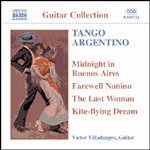
Tango Argentino (Incls 'Midnight in Buenos Aires' by Piazzolla)
 $25.00
Out of Stock
$25.00
Out of Stock6+ weeks add to cart
TANGO ARGENTINA
Tango Argentino (Incls 'Midnight in Buenos Aires' by Piazzolla)
Victor Villadangos (guitar)
[ Naxos Guitar Collection / CD ]
Release Date: Friday 2 April 2004
This item is currently out of stock. It may take 6 or more weeks to obtain from when you place your order as this is a specialist product.
"This new Naxos release provides a really fine cross-section of twentieth century Argentinean tango music...The Argentinean soloist Victor Villandangos is an inspired choice for these warm and colorful tango works" (musicweb)
"This new Naxos release provides a really fine cross-section of twentieth century Argentinean tango music...The Argentinean soloist Victor Villandangos is an inspired choice for these warm and colorful tango works from his fellow-countrymen and his marvelous playing is most spacious, descriptive and expressive. He makes light work of the virtuoso demands of even the most technically challenging works whilst still maintaining an exceptionally high degree of panache and inspirational spontaneity. Villandangos's tone is exceptionally attractive and is assisted by the real fine sound quality...Exceedingly appealing music exceptionally well played. Naxos has a sure-fire winner here."
-- Michael Cookson, musicweb.
The tango is essentially associated with Buenos Aires and its racial and cultural amalgam. It is derived from the cross-cultural influences of the Spanish, native Indians and Negroes, colonists, indigenous inhabitants and slaves. The first of these influences was the candombe heard in the first quarter of the nineteenth century among the porteños of Concepción, San Telmo and Monserrat, the so-called 'districts of the drum'. Then, in the second half of the nineteenth century, the habanera, of Spanish origin, came to the Argentines from Cuba with the boats that sailed to Buenos Aires for cargos of salted beef. This and the Andalusian fandango were taken up by the criollos, who made various various rhythmic modifications which in turn led to the milonga, inspired by the candombe, adapted by the criollos, bringing together African feeling and the spirit of the people of the River Plate districts.
While in the ball-rooms of Buenos Aires and Montevideo, people danced European polkas and mazurkas, in the slums there was a native sensuality in the milonga. From the ranches came payadores, gaucho singers, with their melodies, and the tango would first have been seen on the dirt patios of the pulpería (saloons). The sung verses began to have their own style and themes and from these and the milongas came the new music that would be called the tango, bringing together the gaucho and the candombe of the blacks. A futher influence was that of the Italian immigrants, with their own feeings of nostalgia.
Tracks:
71 Milonga
Coming Back
Farewell Nonino
For the tilingos
Jacinto Chiclana
Kite-flying Dream
La Recoleta
Libertango
Melancholic
Midnight in Buenos Aires
Military Tap
Milonga of Confusion
Milonga of My Loves
Nostalgic
South
The Day You Love Me
The Last Woman
Triumphal



